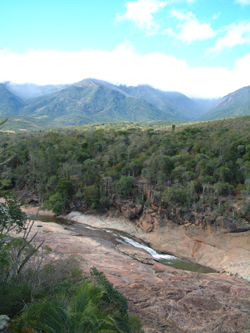Andohahela National Park

| Andohahela National Park | |
|---|---|
| Location | Anosy - southern Madagascar |
| Nearest city | Tôlanaro (Fort Dauphin) |
| Area | 760 km2 |
| Established | 1997 |
| Visitors | approx. 1300 (in 2005) |
| Governing body | Madagascar National Parks Association (PNM-ANGAP) |
Andohahela National Park, in southeast Madagascar, is remarkable for the extremes of habitats that are represented within it. The park covers 760 square kilometers of the Anosy mountain range, the southernmost spur of the Malagasy Highlands. These mountains form a natural barrier to the moist trade winds that blow from the east, causing a rainfall of 1500 to 2000mm per year on their eastern side that supports one of the few rainforests south of the tropic of Capricorn. At the western edge of the park, the rainfall is just 600 to 700mm per year and the resulting vegetation is a dry spiny forest characteristic of southern Madagascar. In the area between these two climatic extremes is a unique transitional forest known as the Ranopiso transition, which is characterised by the locally endemic triangular palm, Dypsis decaryi.
The variety of habitats within Andohahela is mirrored in the richness of species that are found there. Fifteen species of lemur have been recorded, including two of Madagascar's most emblematic species, the ring-tailed lemur and Verreaux's sifaka.
Several circuits within each of the habitat types of the park can be accessed by road from the town of Tolagnaro. Detailed information on arranging trips is available from the tourism information office or from the Madagascar National Parks Association (PNM-ANGAP)office in Tolagnaro.
This National Park was inscribed in the World Heritage Site in 2007 as part of the Rainforests of the Atsinanana.[1]
| Location | Habitat Type | Species |
|---|---|---|
| Malio (Parcel 1) | Rain forest |
Day viewing:
Night viewing:
|
| Ihazofotsy (Parcel 2) | Spiny forest |
Day viewing:
Night viewing:
|
| Tsimelahy (Parcel 3) | Transitional forest |
|
See also
References
- ^ "Africa, Rainforests of the Atsinanana, Madagascar" [1]. UNESCO Organization.
- ^ Mittermeier, R.A.; Louis, E.E.; Richardson, M.; Schwitzer, C.; et al. (2010). Lemurs of Madagascar. Illustrated by S.D. Nash (3rd ed.). Conservation International. p. 633. ISBN 978-1-934151-23-5. OCLC 670545286.
External links
- Andohahela National Park Official site


